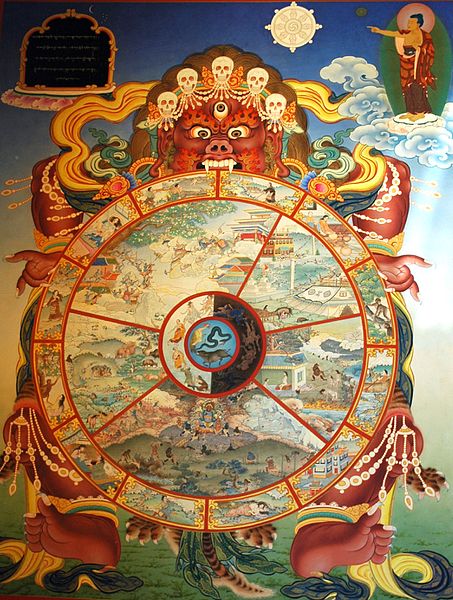Featured image credit: Wonderlane from Seattle, USA, licensed under the Creative Commons Attribution 2.0 Generic license. View a larger version here.
One of the core concepts of Buddhism is the idea of “dependent origination”. This is a bit like the idea of cause and effect, but with a well-developed structure around how it applies to beings and how they experience reality, birth and rebirth.
The Pāli canon, the earliest record of the Buddha’s teachings, contains many renditions of dependent origination. Some of the most concise and most frequently cited are found in the Connected Discourses (Saṃyutta Nikāya). The following is an excerpt from the Connected Discourses on Causation (Nidānasaṃyutta):
And what, bhikkhus, is dependent origination? With ignorance as condition, volitional formations come to be; with volitional formations as condition, consciousness; with consciousness as condition, name-and-form; with name-and-form as condition, the six sense bases; with the six sense bases as condition, contact; with contact as condition, feeling; with feeling as condition, craving; with craving as condition, clinging; with clinging as condition, existence; with existence as condition, birth; with birth as condition, aging-and-death, sorrow, lamentation, pain, displeasure, and despair come to be. Such is the origin of this whole mass of suffering. This, bhikkhus, is called dependent origination.
SN 12.1, p.533 The Connected Discourses of the Bhuddha Volume I, by Bikkhu Bodhi, Wisdom Publications 2000.
Extracting from these twelve links, or Nidānas, we get the following states:
- Ignorance
- Volitional formations
- Consciousness
- Name-and-form
- Six sense bases
- Contact
- Feeling
- Craving
- Clinging
- Existence
- Birth
- Aging-and-death, etc
It is important to point out that fundamentally the Nidānas are actually the links between each of these states, not the states themselves. From the passage quoted above, this becomes clear, since each link is of the form “with this as condition, that comes to be.”
Much could be said about each of the states, but this article will just give an overview of each of them, and how they relate to the Wheel of Life. At this point, it would be worth taking a look at the larger resolution image of the Wheel of Life, here, paying close attention to the outer twelve segments.
1. Ignorance (Avidyā)

First (or, more accurately, following aging-and-death) we have ignorance. In this Wheel of Life, ignorance is depicted by a blind man wandering around in the world. It is just a metaphor – it is certainly not saying that blind people are ignorant! Indeed, sometimes it is represented as someone wearing a blindfold. The metaphor here is that because the person is unable to see the Dharma and, more generally, the true nature of reality, he stumbles through life.
This is what the Buddha says about ignorance:
And what, bhikkhus, is ignorance? Not knowing suffering, not knowing the origin of suffering, not knowing the cessation of suffering, not knowing the way leading to the cessation of suffering. This is called ignorance.
The Buddha, SN 12.2
2. Volitional formations (Saṅkhāra)
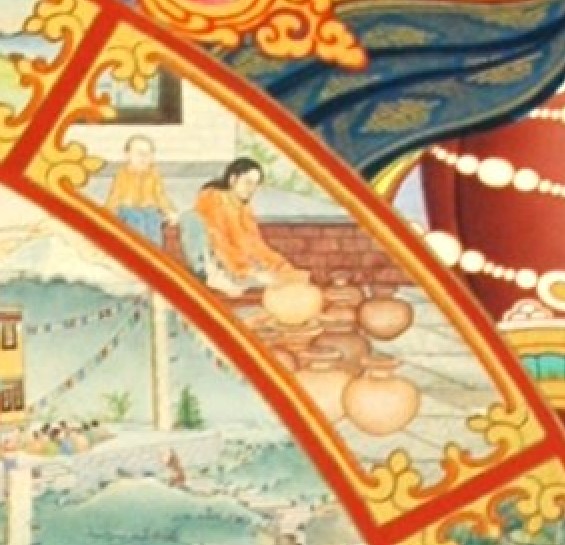
Following ignorance comes volitional formations. This is quite a detailed subject, and is sometimes translated alternatively as “fabrications”, “constructions” or “choices”. It is the medium of karma – our actions, work or deeds go on to create karma. From the Buddha’s explanation, it is said that there are three kinds of volitional formation:
And what bhikkhus, are the volitional formations? There are these three kinds of volitional formations: the bodily volitional formation, the verbal volitional formation, the mental volitional formation. These are called the volitional formations.
The Buddha, SN 12.2
The Wheel of Life here represents volitional formations as a woman making pots on a potters wheel as a metaphor for how she “moulds” her own volitional formations, and thus her karma. I like the artist’s addition of someone, perhaps a child, sitting close by watching her make her pots, as it adds the idea that our volitional formations are not private but are ultimately shared with others.
3. Consciousness (Vijñāna)

Volitional formations give rise to consciousness. In the context of dependent origination as we are looking at it, it might be understood to mean the different kinds of “reactive” or “major” consciousness that are present in unenlightened beings. One of the aims of the path is to gain control over the reactive nature of our conscious minds.
And what, bhikkhus, is consciousness? There are these six classes of consciousness: eye-consciousness, ear-consciousness, nose-consciousness, tongue-consciousness, body-consciousness, mind-consciousness. This is called consciousness.
The Buddha, SN 12.2
The Wheel of Life image representing consciousness is intended to demonstrate several different kinds of consciousness arising together spontaneously, unconstrained, with two monkeys interacting as they climb a tree, perhaps to find food.
4. Name-and-form (Namarupa)

From consciousness there arises name-and-form, which is sometimes also referred to as mentality-materiality, or body-mind.
And what, bhikkhus, is name-and-form? Feeling, perception, volition, contact, attention: this is called name. The four great elements and the form derived from the four great elements: this is called form. Thus this name and this form are together called name-and-form.
The Buddha, SN 12.2
In our Wheel of Life segment for name-and-form we see a picture of a man and a woman rowing in a little boat. This is a metaphor for the journey of life, how the mind and body are interdependent and together they carry the individual through the river of saṃsāra.
5. Six sense bases (Āyatana)

The six sense bases are the ways in which we perceive different aspects of reality. They are:
- Eye and visible objects
- Ear and sound
- Nose and odour
- Tongue and taste
- Body and touch
- Mind and mental objects
And what, bhikkhus, are the six sense bases? The eye base, the ear base, the nose base, the tongue base, the body base, the mind base. These are called the six sense bases.
The Buddha, SN 12.2
In the Wheel of Live, the six sense bases are sometimes depicted by a house with five windows and a door, representing the “portals” through which we sense reality. In this particular version, it is more abstractly depicted by a house with numerous windows and doors, which might be thought of as placing an emphasis on the fact that there are many ways through which the external (and internal) world can connect with our consciousness.
6. Contact (Sparśa)

Next we have contact, which naturally arises from the six sense bases. Whenever we perceive the world, internal or external, via one or more of our senses, there is contact. This could also be thought of as “stimulation” or “sensation”.
The Buddha explains that these map one-to-one onto the six sense bases, thus:
And what, bhikkhus, is contact? There are these six classes of contact: eye-contact, ear-contact, nose-contact, tongue-contact, body-contact, mind-contact. This is called contact.
The Buddha, SN 12.2
In the Wheel of Life, contact is often represented by a couple embracing and kissing, and thereby giving rise to all kinds of contact.
7. Feeling (Vedanā)
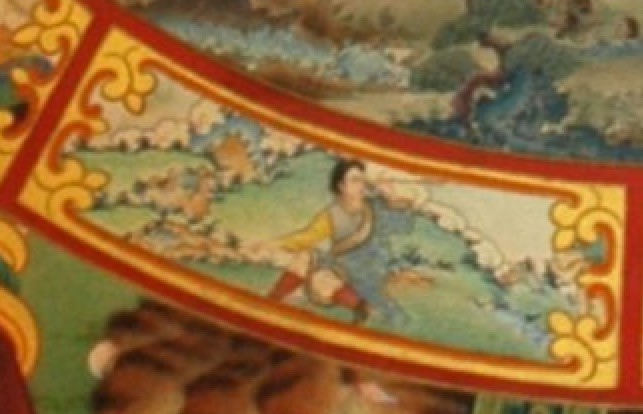
From contact there arises feeling. In the Wheel of Life, this is usually depicted by a person with an arrow in their eye, which is a vivid metaphor for a painful kind of feeling – a common source of suffering. There are also pleasant feelings and neutral feelings. The arrow in the eye, as well as being painful, is also a metaphor for how we may become “blinded” to the way, or return to ignorance, if we react to our feelings in unskilful ways.
And what, bhikkhus, is feeling? There are these six classes of feeling: feeling born of eye-contact, feeling born of ear contact, feeling born of nose-contact, feeling born of tongue-contact, feeling born of body-contact, feeling born of mind-contact. This is called feeling.
The Buddha, SN 12.2
8. Craving (Taṇhā)
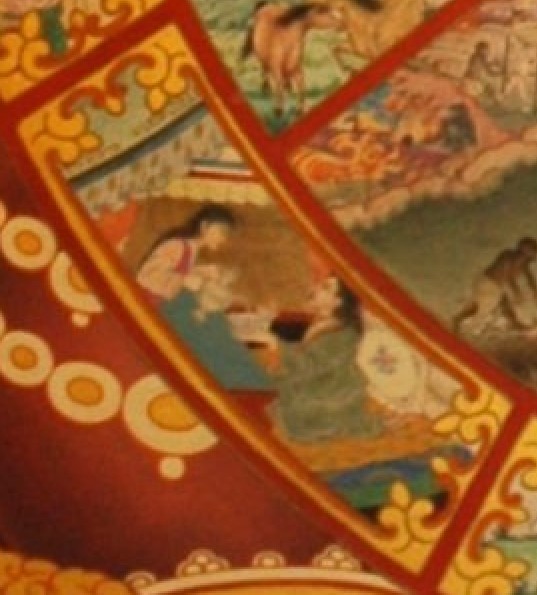
From feeling there arises craving. If we delight in pleasant feelings we end up wanting more from the source of those pleasant feelings. If we are averse to unpleasant feelings we end up wanting to repel the source of those unpleasant feelings.
And what, bhikkhus, is craving? There are these six classes of craving: craving for forms, craving for sounds, craving for odours, craving for tastes, craving for tactile objects, craving for mental phenomena. This is called craving.
The Buddha, SN 12.2
The Wheel of Life usually depicts craving with a picture of a woman giving a drink to a man, symbolising how we “thirst” for more.
9. Clinging (Upādāna)
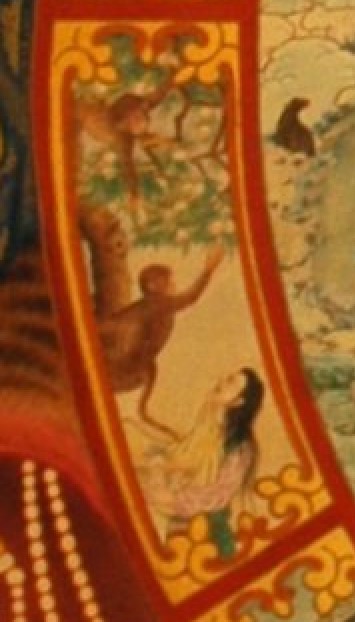
Craving gives rise to clinging, sometimes also referred to as “attachment” or “grasping”. When we are unwilling to let go of our cravings, we cling to them. If allowed to progress and evolve, clinging can be a major source of suffering. This is because the things that are clung to are impermanent.
And what, bhikkhus, is clinging? There are these four kinds of clinging: clinging to sensual pleasures, clinging to views, clinging to rules and vows, clinging to a doctrine of self. This is called clinging.
The Buddha, SN 12.2
The Wheel of Life usually represents clinging by the metaphor of someone picking fruit from a tree. In this particular version, a pair of monkeys seem to be helping the person by climbing the tree and handing down the fruit. This adds extra depth to the metaphor, since the person is dependent upon the fruit and the monkeys.
10. Existence (Bhava)
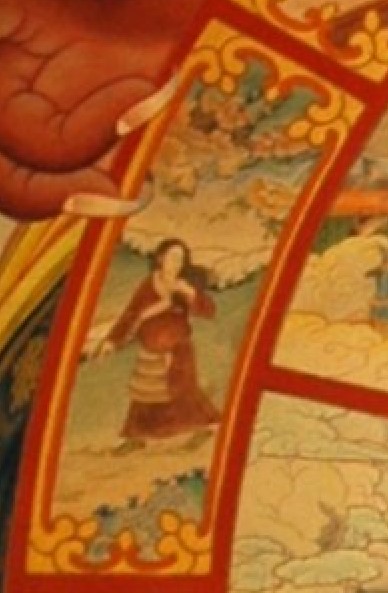
From clinging arises existence, sometimes also called “becoming” or “being”. Existence is the link between the defilements of craving and clinging, and the endless cycle of rebirth.
And what, bhikkhus, is existence? There are these three kinds of existence: sense-sphere existence, form-sphere existence, formless-sphere existence. This is called existence.
The Buddha, SN 12.2
The three “planes” of existence are inhabited by beings dependent upon their accumulated karma.
Many beings live in the sense-sphere existence, where desire and aversion predominate. The form-sphere is inhabited by beings who experience subtle physical form and experience higher states of consciousness such as the first four absorptions (jhānas) which arise from meditation. The formless-sphere is an even higher state of being, and is associated with the highest meditative states of infinite space, infinite consciousness, neither perception nor non-perception and nothingness.
In the Wheel of Life, existence is usually depicted as a beautiful bride, symbolising the worldly facets of sense-sphere existence.
11. Birth (Jāti)

From existence arises birth. The Wheel of Life represents this quite literally with a picture of a woman giving birth to a child. Depending on your karmic merit, assuming you have not reached enlightenment, your rebirth will be into one of the six realms:
- Devas (“gods”)
- Asuras (“titans”, often depicted as enemies of the Devas)
- Hungry ghosts
- Hell
- Animals
- Humans
And what, bhikkhus, is birth? The birth of the various beings into the various orders of beings, their being born, descent into the womb, production, the manifestation of the aggregates, the obtaining of the sense bases. This is called birth.
The Buddha, SN 12.2
The six realms are depicted in the large inner section of the Wheel of Life. In this particular version, the Devas and the Asuras share the same large segment, and are at war:
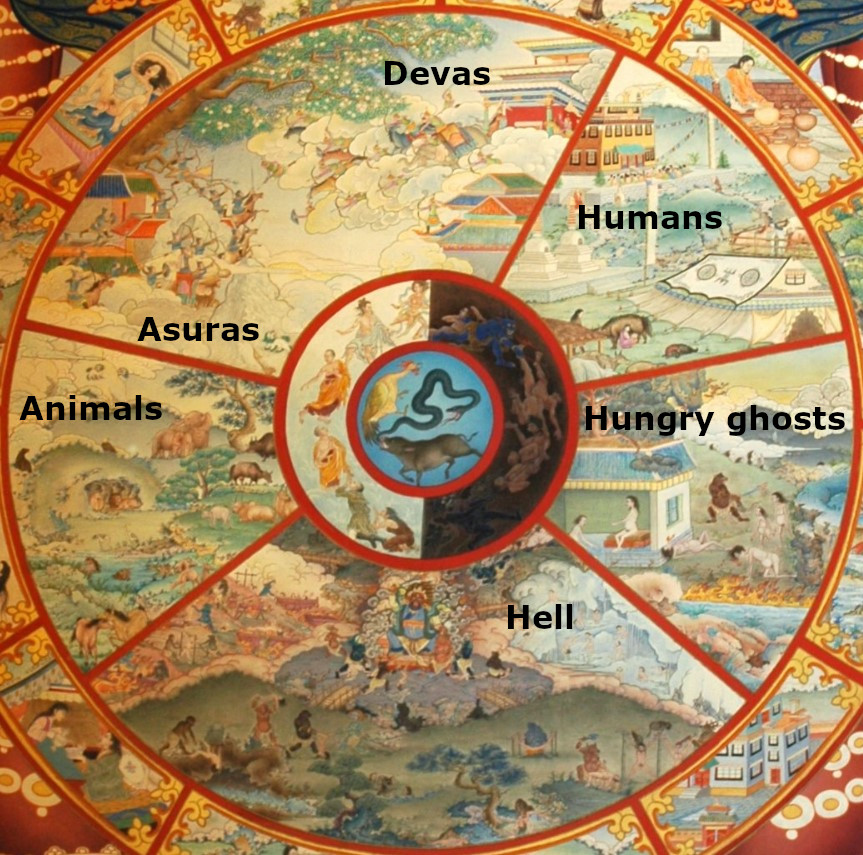
12. Aging-and-death (Jarāmaraṇa)

From birth there arises aging-and-death, and all other things associated with decay. The Wheel of Life usually represents this as a dead body being carried to a “charnel ground”, an open place where the dead are brought, usually to be cremated.
And what, bhikkhus, is aging-and-death? The aging of the various beings in the various orders of beings, their growing old, brokenness of teeth, greyness of hair, wrinkling of skin, decline of vitality, degeneration of the faculties: this is called aging. The passing away of the various beings from the various orders of beings, their perishing, breakup, disappearance, mortality, death, completion of time, the breakup of the aggregates, the laying down of the carcass: this is called death. Thus this aging and this death are together called aging-and-death.
The Buddha, SN 12.2
The Two Ways
The Buddha teaches that there are two “ways”: the wrong way and the right way.
If we take the wrong way, we remain stuck on the Wheel of Life. The wrong way is achieved by allowing each of the Nidānas to continue, each giving rise to the next, in an endless cycle of birth and rebirth.
If we take the right way, we can ultimately achieve enlightenment. The right way is achieved by contemplating and achieving the remainderless fading away and cessation of the Nidānas.
Where to begin?
You might ask “where do I begin?” since there are twelve Nidānas and it isn’t immediately obvious how we can begin this process of “contemplating and achieving the remainderless fading away and cessation” of any particular one of them. As you might expect, the Buddha has an answer: We can achieve this by starting out at the stage where feelings contemplated by the mind give rise to craving and clinging:
Bhikkhus, when one dwells contemplating gratification in things that can be clung to, craving increases. With craving as condition, clinging comes to be; with clinging as condition, existence; with existence as condition, birth; with birth as condition, aging-and-death, sorrow, lamentation, pain, displeasure, and despair come to be. Such is the origin of this whole mass of suffering.
Suppose, bhikkhus, a great bonfire was burning, consuming ten, twenty, thirty, or forty loads of wood, and a man would cast dry grass, dry cowdung, and dry wood into it from time to time. Thus, sustained by that material, fuelled by it, that great bonfire would burn for a very long time. So too, when one lives contemplating gratification in things that can be clung to, craving increases.… Such is the origin of this whole mass of suffering.
Bhikkhus, when one dwells contemplating danger in things that can be clung to, craving ceases. With the cessation of craving comes cessation of clinging; with the cessation of clinging, cessation of existence … cessation of birth … aging-and-death, sorrow, lamentation, pain, displeasure, and despair cease. Such is the cessation of this whole mass of suffering.
SN 12.52
